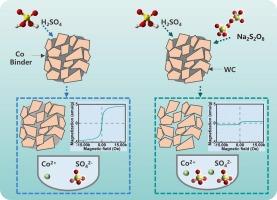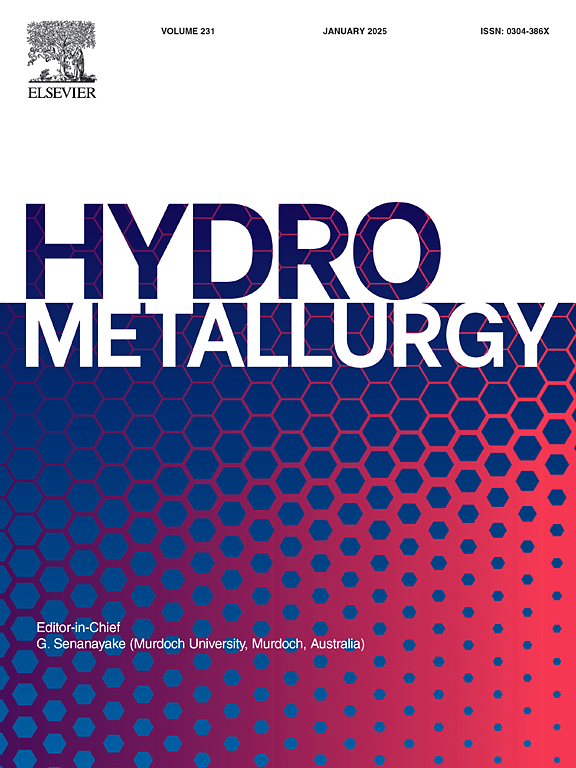利用硫酸-过硫酸钠混合溶液从硬质合金研磨废料中高效分离和回收钴
IF 4.8
2区 材料科学
Q1 METALLURGY & METALLURGICAL ENGINEERING
引用次数: 0
摘要
硬质合金的机械加工通常会产生大量的硬质合金研磨废料(GWCC),这些废料是回收钴和钨的重要二次资源。本研究测试了一种使用 H2SO4-Na2S2O8 混合溶液从 GWCC 中分离出 Co 的高效工艺。在 20 g/L H2SO4、30 g/L Na2S2O8、60 °C 和 1 小时的最佳条件下,钴的浸出效率达到 97.0%,而单独使用 H2SO4 时仅为 58.6%。H2SO4 和 H2SO4-Na2S2O8 溶液中的钴浸出动力学被确定为化学反应控制和扩散控制的结合,表明引入 Na2S2O8 后,H2SO4 溶液中的钴浸出率显著提高。最后,通过草酸沉淀和真空热解,实现了钴的完全回收,并从浸出液中制备出具有花簇形态的纯钴粉。再生 WC 和 Co 粉可循环用于硬质合金生产。本文章由计算机程序翻译,如有差异,请以英文原文为准。

Efficient separation and recovery of cobalt from grinding waste of cemented carbide using a sulfuric acid-sodium persulfate mixed solution
The mechanical processing of cemented carbide often generates a considerable amount of grinding waste from cemented carbide (GWCC), which serves as an important secondary resource for recovering Co and W. However, efficient separation of tungsten carbide (WC) and Co from GWCC remains challenging. This study tested an efficient process for separating Co from GWCC using a mixed solution of H2SO4-Na2S2O8. Under optimum conditions of 20 g/L H2SO4, 30 g/L Na2S2O8, 60 °C, and 1 h, the leaching efficiency of Co reached 97.0 %, compared to only 58.6 % when using H2SO4 alone. The kinetics of Co leaching in H2SO4 and H2SO4-Na2S2O8 solutions were determined to be a combination of chemical reaction control and diffusion control, suggesting that Co leaching rate in H2SO4 solution is significantly enhanced by introducing Na2S2O8. Finally, complete recovery of Co was achieved, and pure Co powder with a flower-cluster morphology was prepared from the leaching solution through oxalic acid precipitation followed by vacuum pyrolysis. The regenerative WC and Co powder can be recycled for cemented carbide production.
求助全文
通过发布文献求助,成功后即可免费获取论文全文。
去求助
来源期刊

Hydrometallurgy
工程技术-冶金工程
CiteScore
9.50
自引率
6.40%
发文量
144
审稿时长
3.4 months
期刊介绍:
Hydrometallurgy aims to compile studies on novel processes, process design, chemistry, modelling, control, economics and interfaces between unit operations, and to provide a forum for discussions on case histories and operational difficulties.
Topics covered include: leaching of metal values by chemical reagents or bacterial action at ambient or elevated pressures and temperatures; separation of solids from leach liquors; removal of impurities and recovery of metal values by precipitation, ion exchange, solvent extraction, gaseous reduction, cementation, electro-winning and electro-refining; pre-treatment of ores by roasting or chemical treatments such as halogenation or reduction; recycling of reagents and treatment of effluents.
 求助内容:
求助内容: 应助结果提醒方式:
应助结果提醒方式:


